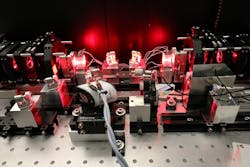The Fraunhofer Institute for Laser Technology (Fraunhofer ILT; Aachen, Germany) is developing satellite-based laser beam sources for climate research. The project ALISE (Diode-pumped Alexandrite Laser Instrument for next generation Satellite-based Earth observation) started in August 2016 and will run until July 2018. In cooperation with the Leibniz Institute for Atmospheric Physics (IAP) and Airbus Defence & Space, the Fraunhofer ILT will be investigating the technical feasibility and the possible applications of a novel alexandrite laser system for satellite-based observation of the world's climate.
RELATED ARTICLE: Crystalline supermirrors enhance spectroscopy for improved chemical kinetics understanding
To develop effective measures against global warming, scientists need climate models that reliably represent interrelationships in the atmosphere. Currently, there is insufficient data about such relationships at high altitude (mesosphere), where crucial processes for global air circulation occur. For the measurement of temperature and wind speed at this altitude, climate researchers rely on the modern resonance-lidar process. However, due to the complexity and the weight, these laser measuring systems are being used almost exclusively on the ground. The work in ALISE constitutes the first step in developing a satellite-based observation system that enables wind and temperature conditions to be measured temporally and spatially in high-resolution in the mesosphere. To accomplish this, the efficiency of the laser beam source, an alexandrite laser, needs to be increased by using laser diodes as a pump source. Furthermore, complexity and component weight will be reduced so that the requirements for space-based missions can be met.
In order to take advantage of laser measurement technology in satellite-based Earth observation, the scientists from Aachen have applied their many years of experience and expertise to developing laser beam sources and optical components for atmospheric measurements. They were already able to demonstrate this, among others, in the Franco-German climate mission MERLIN and the CHARM-F project. The CHARM-F system recently successfully completed its first flight on the German research aircraft HALO (High Altitude and Long Range Research Aircraft) of the German Aerospace Center (DLR).
ALISE is supervised by the DLR; please visit http://www.dlr-innospace.de/startseite/gefoerderte-projekte/alise/.
SOURCE: Fraunhofer ILT; http://www.ilt.fraunhofer.de/en/press/press-releases/PR2017/press-release-2017-01-09.html

